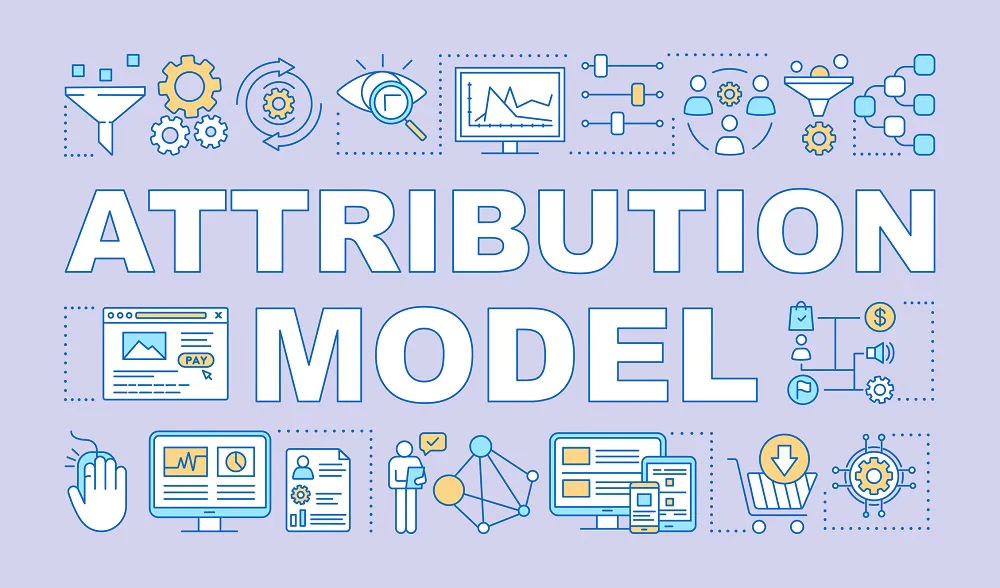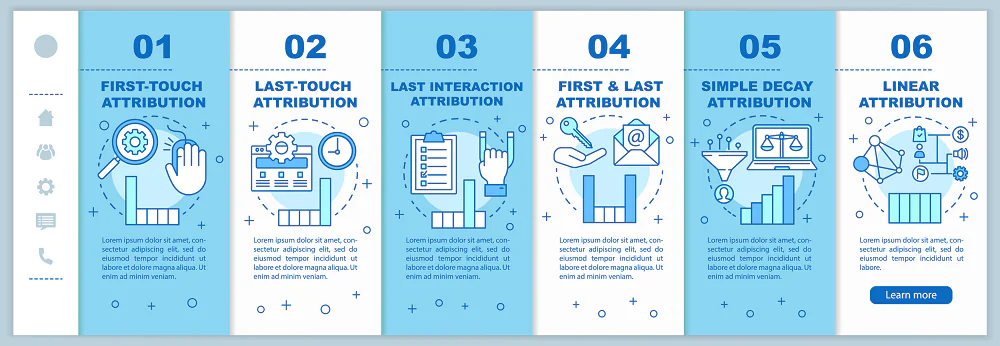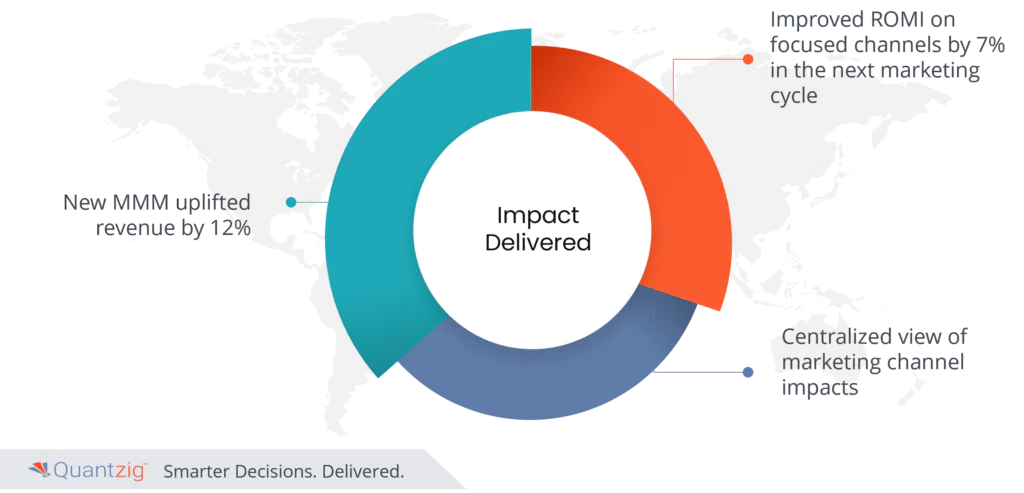Written by: Medha Banerjee
Table of Contents
Key Takeaways in Marketing Attribution Modelling in CPG:
- Agility in Planning: Embrace data-driven, weekly refreshes to adapt marketing strategies, marketing effectiveness and marketing measurements dynamically throughout the year.
- Holistic Attribution: Develop robust attribution models to accurately measure channel contributions, especially in the absence of direct revenue tracking.
- Simulation Capabilities: Empower marketing teams with simulation tools to explore diverse budgeting scenarios and optimize channel allocations effectively.
Introduction
The journey to making a purchase seldom follows a direct route. Attribution models have emerged as indispensable tools for channel managers and marketers seeking insights into user behavior and ways to enhance their business efforts by incorporating methods like machine learning. Whether it’s through various channels, machine learning or engaging with your brand across platforms, customers interact in diverse ways using customer data before progressing through the sales funnel. This complexity underscores the importance of understanding user engagement, new competitors and employing effective mobile measurement techniques for audience segments, especially for mobile marketers and channel managers keen on optimizing in-app purchases (IAPs), do their performance measurements and boosting retention rates.
Quantzig’s Unified Marketing Decision Management (MDM) begins with holistic measurement & attribution of spending. The services are set to ease your choosing options based on your specific business requirements.
Book a demo to experience the meaningful insights we derive from data through our analytical tools and platform capabilities. Schedule a demo today!
Request a Free DemoQuantzig’s Marketing Attribution Modelling Services: A Case Study
| Client Location | US |
| Challenges Faced | CPG Multinational with centralized budgeting and decentralized execution. Outdated MMM unable to provide dynamic plans for digital adoption like digital channels. |
| Solution Offered by Quantzig | Updated MMM + MTA solution with weekly data for adaptive planning. Developed attribution models for revenue share. Calculated baseline revenue, channel-wise breakdown. Identified spend efficiencies with Marketing ROI measurements and provided a simulation toolkit for analysts. |
| Impact Delivered | New MMM uplifted revenue by 12%. Improved ROMI on focused channels by 7% in the next marketing cycle. |
Standing today, where digital and physical channels intersect, optimizing Return on Marketing Investment (ROMI) has become paramount for Chief Marketing Officers (CMOs) worldwide. With a plethora of channels and dynamic consumer buying behaviours, the challenge lies in crafting integrated marketing frameworks for the channel managers, that not only allocate budgets strategically but also respond to market risks, market share, operations analytics and opportunities in real-time.
Read more: Power of Marketing Business Intelligence for Success
Challenges in Attribution Modelling in Marketing
Imagine a use case where a Consumer Packaged Goods (CPG) multinational, operating in the competitive US market, grapples with centralized budgeting and decentralized execution across digital and non-digital channels. Their existing Marketing Mix Modeling (MMM) approach, with its annual planning cycle, fails to adapt to the dynamic nature of digital marketing, digital sales or leverage internal performance data effectively.
Read more: How AI for Marketing Changes the Game?
The Quantzig Solution for Attribution Modelling Marketing
Enters Quantzig, a leading analytics and advisory firm, offering a comprehensive Marketing Mix Modeling(MMM) + Multi-Touch Attribution (MTA) solution and Unified Measurement Approaches (UMA). By refreshing the modelling framework of the Consumer Packaged Goods (CPG) with weekly data updates, Quantzig enabled the client to embrace a more adaptive planning approach, capturing the recency effect throughout the year.
The journey began with building an intelligence layer, followed by developing attribution models for channels lacking direct revenue recognition mechanisms. Quantzig then delved into calculating baseline revenue and dissecting overall revenue into channel-specific contributions. Sensitivity analyses and Marketing ROI measurements were conducted to establish efficient boundaries for channel spend. Additionally, a simulation toolkit empowered analysts to explore various budgeting scenarios and channel allocations.
Experience the advantages firsthand by testing a customized complimentary pilot designed to address your specific requirements. Pilot studies are non-committal in nature.
Request a Free PilotThe Impact Delivered Using Attribution Model
The results were tangible and impressive. The new Marketing Mix Modeling (MMM) framework and Unified Measurement Approaches (UMA) delivered a remarkable 12% uplift compared to the incumbent model. Moreover, the client witnessed a notable 7% improvement in ROMI across targeted channels in the immediate marketing cycle following the solution’s adoption.
In the quest for industry disruption by optimizing ROMI and marketing measurements by integrating frameworks with visual dashboards, real-time analytics advanced analytics and machine learning solutions is not just a choice but a necessity. This success story of a Consumer Packaged Goods (CPG) multinational client sheds light on the transformative power of integrating agile planning methodologies, POS data and data-driven insights. As this competitive marketing landscape significantly continues to evolve, integrating intelligent customized solutions will be the cornerstone of long-term competitive advantage and sustainable growth.
The Quantzig team is committed to applying innovative approaches like Unified Measurement Approaches (UMA) that provide profitable business outcomes with effective marketing measurements and resources. Contact us today to embark on your journey towards maximizing Return on Investment in an ever-changing world.
Get started with your complimentary trial today and delve into our platform without any obligations. Explore our wide range of customized, consumption driven analytical solutions services built across the analytical maturity levels.
Start your Free TrialMarketing Attribution Modelling: An Overview

While businesses are advancing in a fast pace, individual attribution models alone cannot furnish marketers of CPG Brands with a comprehensive understanding of the addressable touchpoints driving conversions. To effectively optimize marketing efforts and grasp the influence of touchpoints across various online and offline channels, marketers, including mobile marketers, must integrate multiple models within an omnichannel strategy.
This approach entails evaluating the insights provided by each model, including last-click, Last-interaction attribution model, Z-shaped attribution, and last-touch attribution models, as well as multi-touch attribution (MTA) and view-through attribution (VTA) for the desired business outcome. By combining these models, CPG brand marketers can gain a holistic view of user behavior, user engagement, and retention, thereby optimizing their business strategies to maximize revenue.
Additionally, leveraging tools like the Z-shaped attribution, Adjust Multi-Touch solution and CallRail attribution modeling tool can enhance mobile measurement for the CPG Brands via omni-channel campaigns and provide deeper insights into advertising interactions across different traffic sources and help in tackling new competitors. This integrated approach enables advertisers to allocate their marketing budget more effectively, identifying the most impactful touchpoints and channels for driving B2B revenue.
In marketing attribution modeling, the last-interaction attribution model assigns credit solely to the final touchpoint before conversion, offering a simplistic view of customer journey impact. Conversely, the last-touch attribution model encompasses all interactions preceding conversion, providing a more comprehensive understanding of customer engagement. Leveraging platforms like Google Search Ads, beacon technology, display advertising, point-of-sale surveys, online events, and specialized B2B revenue attribution platforms enables marketers, salespeople, and CEO to refine their strategies through phones, attributing revenue accurately across touchpoints for informed decision making and enhanced campaign effectiveness and campaign metrics.
In summary, by retail embracing a comprehensive guide like ad frequencies, incorporating various models and tools like beacon technology, empowers marketers and small companies to better understand user behavior, optimize marketing efforts, and drive revenue across the entire marketing mix. This approach entails evaluating the value and insights offered by each attribution model and selecting those most suited to the organization’s analytics requirements. By amalgamating these insights from sources like omni-channel campaigns, marketers can gain a comprehensive view of attribution, facilitating the optimization of campaign efforts across the entire marketing mix.
Choosing the Right Attribution Model
Discovering the right attribution model is crucial for marketers seeking insights into consumer behavior and campaign effectiveness, especially in the realm of marketing, where mobile marketers face unique challenges and sustainability comes as a concern. To select the best-fit model from the array of available options such as last-click attribution, omni-channel campaigns, last-interaction attribution model, and multi-touch attribution (MTA), understanding their value and challenges they pose is essential.
Aligning with the unique sales cycle and considering factors like user behavior, in-store marketing materials, sales rates, in-app purchases (IAPs), and user engagement aids in decision-making. These insights not only optimize marketing efforts but also contribute to enhancing user retention and ultimately driving revenue for advertisers.
In the mobile marketing landscape, where traffic sources vary and business strategies constantly evolve, tools like the Adjust Multi-Touch solution or CallRail attribution modeling tool become invaluable. They provide a comprehensive view of attribution, encompassing various touchpoints across different advertising budgets and interactions, avoiding wasted spend and including Google search ad, SQLs, and enable marketers to effectively allocate their budget.
By leveraging advanced techniques and integrating view-through attribution (VTA), such as those offered by B2B revenue attribution platform and global markets, similar to Social Networks, business marketers can gain in-depth insights into the impact of their present marketing efforts with target audience specific individuals. This holistic data-driven approach ensures that strategies are properly optimized to maximize the Marketing ROI and drive long-term success.
Read more: Navigating User and Customer Filtering in Audience Analytics
6 Prevalent Marketing Attribution Models:

Attribution Models for Short Sales Cycles:
- First-Touch Attribution: Recognizes the initial granular level touchpoint through social networks along the sales cycle, offering insights into brand introduction.
- Last-touch attribution model: Identifies the last touchpoint before conversion, valuable for understanding bottom-funnel influences.
Attribution Models for Longer Sales Cycles:
- U-Shaped Attribution: Distributes credit across the sales cycle, emphasizing first and last touches, personalized experiences ideal for identifying effective media and messaging combinations.
- W-Shaped Attribution: Prioritizes first, last, and mid-funnel touches, offering insight into lead conversion rates and engagement intent.
- Time-Decay Attribution: Increases touchpoint value as consumers approach conversion, beneficial for pinpointing conversion-driving creative touchpoints.
Attribution Models for Insights into Audience Behaviour:
- Linear Attribution: Assigns equal value across the sales cycle, providing a holistic view of the customer journey using video platforms or digital platforms and digital advertising and digital marketing efforts with dynamic content, albeit without pinpointing ROI-driving touchpoints.
In the marketing attribution modeling, the last-interaction attribution model focuses solely on the final touchpoint and ad measurement before conversion, providing a simplified perspective of customer engagement, which is often done via Social Networks. Conversely, the last-touch attribution model encompasses all preceding interactions, offering a more wholesome view. Utilizing platforms like Google Search Ads, buyer journey, and specialized B2B revenue attribution platforms enhances marketers’ ability to accurately attribute revenue across touch points, facilitating data-driven decision-making, composed display advertising to justify marketing value, and optimizing campaign performance aligned with the evolved customization, enriched targeting cpabilities, Path-to-purchase and the shifts in shopper preferences.
Differences between the Types of Attribution Models in Marketing:
| Attribution Model | Description | Advantages | Disadvantages |
| First-Touch Attribution | Attributes full value to the first touchpoint engaged with along the sales cycle. | Easy to set up and track, provides insights into initial brand introduction. | Ignores the influence of subsequent touchpoints, may not reflect complete consumer journey. |
| Last-touch attribution model | Attributes full value to the last touchpoint engaged with prior to conversion. | Easy to implement, valuable for understanding bottom-funnel influences. | Ignores contributions of earlier touchpoints, may overlook initial brand awareness. |
| U-Shaped Attribution | Assigns heavier credit to the first and last touchpoints, distributing remaining credit among mid-funnel touchpoints. | Highlights contributions of initial and final interactions, useful for identifying effective media and messaging via video platforms, digital advertising or digital platforms. | May oversimplify the role of mid-funnel touchpoints, lacks granularity in attribution. |
| W-Shaped Attribution | Prioritizes first, last, and mid-funnel touchpoints, assigning heavier value to mid-funnel touchpoints where consumers are actively considered leads. | Provides insight into lead conversion, ad measurement and engagement intent, identifies influential touchpoints. | Limits visibility into mid-funnel engagements, may not accurately reflect consumer journey complexity. |
| Time-Decay Attribution | Increases touchpoint value as consumers approach conversion, recognizing varying influences across the sales cycle. | Useful for pinpointing conversion-driving touchpoints, acknowledges evolving consumer behavior with ad measurement and the evolved Path-to-purchase and the shifts in shopper preferences. | Values touchpoints based on engagement position, may not capture impact accurately. |
| Linear Attribution | Assigns equal value to all touchpoints across the sales cycle, offering a comprehensive view of the customer journey and digital marketing efforts. | Provides a holistic view of the customer journey, useful for understanding overall campaign effectiveness. | Doesn’t pinpoint ROI-driving touchpoints, treats all touchpoints equally regardless of influence. |
Conclusion
In conclusion, selecting the right attribution model is pivotal for businesses navigating the complex landscape of analytics and assess the evolved new measures like CRM Data, Path-to-purchase and the shifts in shopper preferences. Agility in planning, holistic attribution, and simulation capabilities offer invaluable insights into user behavior, aiding in dynamic strategy adjustments and effective budget allocation. As marketers strive to maximize ROI with methods like video platforms, digital advertising or digital platforms and drive revenue growth, embracing comprehensive approaches and leveraging advanced tools like display advertising remain essential for success in today’s business environment tactics. With the right strategies in place like creative optimization and competitive edge, businesses can unlock new opportunities, tackle new competitors, enhance customer retention, and stay ahead in the competitive marketplace.




